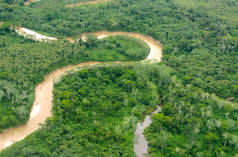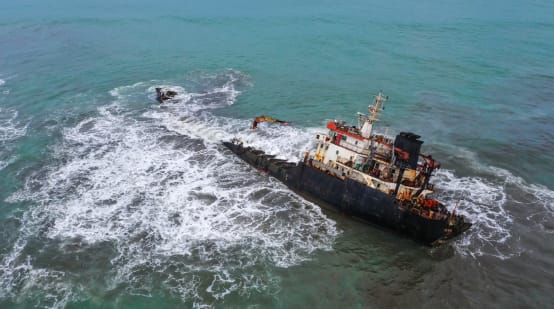Sundarbans em perigo – impedimos a central a carvão Rampal
 Um tigre na água (© Turau / iStock)
Um tigre na água (© Turau / iStock)
Os mangues de Sudarbans resistem a tufões e tsunamis e oferecem um habitat protegido para tigres e seres humanos. O ecossistema foi inscrito no Patrimônio Mundial. Mas os governos da Bangladesh e da Índia estão planejando uma central a carvão a poucos quilômetros. Por favor, exijam do Banco Exim India que rejeite o financiamento.
ApeloPara: Yaduvendra Mathur, presidente do Exim Bank India
“A construção da central a carvão Rampal ameaça a população, animais e plantas no Sundarbans. Por favor, não concedam nenhum crédito.”
Provavelmente, ninguém já contou o número de ilhas ficam no Sundarbans, um território entre água e terra. Podem ser milhares ilhas, nas quais crescem os maiores mangues arbóreos coerentes do mundo. Cerca de 100 tigres vivem nesse tesouro natural no delta dos rios Ganges, Bramaputra e Meghna. Golfinhos fluviais, crocodilos-de-água-salgada e pítons encontram um refúgio nessa região.
Por causa da sua biodiversidade, a UNESCO declarou o coração do Sundarbans como Patrimônio Mundial. Mas atualmente as Nações Unidas estão alarmadas e enviaram especialistas para a região. O paraíso está em perigo.
Na Bangladesh, a somente 14 quilômetros da margem dos manguezais, a central a carvão Rampal está por ser construída. As preparações já estão em andamento. Os governos da Bangladesh e da Índia querem construir o complexo de 1.320 megawatts em conjunto.
Ambientalistas temem o pior: o ecossistema poderia perder o seu equilíbrio e a sobrevivência de inteiras espécies animais está em perigo. Como a central prejudica o rio Passur, o habitat de vários peixes, mariscos e crustáceos e consequentemente uma fonte alimentar para até dois milhões de pessoas estão ameaçados.
Diariamente, a central emite 220 toneladas de gases tóxicos, que poluem o ar, e dióxido de carbono, que acelera o aquecimento global.
A central gigantesca devorará até 500 cargas de carvão por ano – os navios terão que percorrer uma passagem de mais de 65 quilômetros pelo meio do mundo insular. Avarias e fugas de óleo poderiam prejudicar a região ainda mais.
O banco indiano Exim, com uma participação do Estado de 69 por cento, quer financiar a construção com 1,6 bilhões de dólares americanos. Por favor, apóiem a população e a natureza do Sundarbans e exijam do banco que não conceda nenhum crédito.
Mais informaçõesA empresa Bangladesh-India Friendship Power Company Ltd (BIFPCL) está por trás do projeto Rampal – um empreendimento conjunto entre a National Thermal Power Company (NTPC) da Índia e a Power Development Board (BPDB) da Bangladesh.
A organização BankTrack fundou uma aliança internacional de atualmente 92 organizações ambientalistas e de direitos humanos, entre outros a Salve a Floresta, e publicou um apelo ao banco Exim. Isto é o texto completo em inglês:
Stop support for the Rampal Coal Power plant
A Global call to Exim Bank India
Dear Mr. Yaduvendra Mathur, CEO of Exim Bank India,
We, the undersigned organisations from around the world, have learned that your institution intends to finance the construction of the 1,320 MW Rampal coal power plant in Bangladesh via the extension of a ‘buyer’s credit’ of USD 1.6 billion to the operating company Bharat Heavy Electricals (BHEL).
We have received this news with great concern, as we consider the Rampal coal power plant a severe and direct threat, not only to the livelihoods of the local population and to the world renowned Sundarbans wetland adjacent to the project site, but also to the world’s climate.
Exim Bank India is supposed to be an institution that takes its responsibility for the social and environmental impacts of its operations very seriously. After all, your ‘Citizen’s Charter’ states that “the bank […] recognizes its obligations as a citizen of the world” and considers citizens of India and the global community stakeholders of the bank”, while the ‘Export-Import Bank of India Act’ reassures us that “the board […] shall act on business principles with due regard to public interest”.
Our organisations fail to see how Exim Bank India, a self-declared responsible ‘citizen of the world’ acting ‘with due regard to public interest’ could support a project as destructive as the Rampal coal power plant. As ‘global community stakeholders of the bank’ we would like to point out to your bank that this project:
Threatens the livelihoods of over two million people
Over two million people living in villages around the forest depend on the Sundarbans forest’s resources to fulfill their basic needs, while others make use of products to earn a living. The vast majority relies on aquatic resources such as shrimp cultivation or fisheries. Wood is collected for the construction of houses and boats but also for export. Acres of land acquired to build the coal plant were previously used for agriculture and farming activities. With increased river erosion, noise pollution, health hazards and a decrease in the groundwater table as a result of the Rampal coal-fired power plant, there will inevitably be a loss of culture fisheries, social forestry and major destruction of agriculture.
Threatens to destroy the unique, extraordinary rich Sundarbans forest
Climate, topography, land use patterns, air and water (both surface and ground) quality, floral and faunal diversity, wetlands and tourism will be permanently affected by the proposed coal fired power plant. The Rampal plant will pollute the air by releasing toxic gases which will impact people, animals, trees, plants and land. The plant will contaminate rivers by discharging used, warm water into the River Passur daily, for at least 25 years. Additionally the rivers of the Sundarbans will be used as shipping routes to carry coal to the Rampal site. The four recent incidents involving sunken vessels which dumped oil, fertilizer and coal in the rivers stand as clear warnings of the accidents that will take place if the Rampal coal plant plans proceed.
Threatens to wipe out the Bengal tiger
Sundarbans is home to some of the last remaining iconic Bengal tigers, as well as the estuarine crocodile, the Irrawaddy and Ganges dolphins, the Indian python, some 260 bird species and around 120 aquatic species. If the coal power plant becomes operational, the toxic discharged water and polluted air, as well as the constant coal transport, will have a destructive effect on all life in the forest. It is not possible to protect high profile animals in the Sundarbans without a true balance between various ecosystems. Tigers will not be there without the deer, and deer will not be there without the keora tree. If the Sundarbans degenerates we will be forever losing the animals which depend on it, with future generations no longer able to enjoy the splendid sight of these animals.
Threatens to add havoc to the global climate system
The Rampal power plant, once in operation, will emit 7.9 million tons of CO2 per year for the next 25 years, therefore adding a further major load to an atmosphere that is already saturated with greenhouse gases. If the world is to have any chance to limit the global temperature rise below the critical 2 degrees Celsius threshold agreed upon by the countries of the world last year in Paris, let alone the 1.5 degrees threshold considered crucial to keep life on earth more or less as we know it, there must be an immediate end to the construction of all coal plants.
Bangladesh, as well as India and other vulnerable countries, have already been suffering the effects of climate change, with strong storms causing devastating flooding. Weakening the Sundarbans would only leave Bangladesh and parts of India defenseless in the face of natural catastrophes that are now likely to rise in frequency and intensity.
There is an urgent need for institutions such as Exim Bank India to put their full weight behind financing the energy transition which the world urgently needs to meet the challenge of rapid climate change, away from the burning of fossil fuels and towards the full realisation of the potential of renewables.
For all of these reasons we, as fellow world citizens, call upon you, a responsible financial institution acting in the public interest, to act for the common global good and refrain from financing the Rampal coal power plant.
As global stakeholders to your bank we thank you in advance for changing course.
Mais informações:
sobre a campanha da BankTrack
http://www.banktrack.org/rampal/
http://us6.campaign-archive2.com/?u=ca4ff3016df790ab4c04c0ddd&id=64902a1131&e=42702348b5
sobre o Patrimônio Mundial da UNESCO
http://whc.unesco.org/en/list/452 na Índia
http://whc.unesco.org/en/list/798 na Bangladesh
informações gerais sobre a central Rampal, o Sundarbans e sobre manguezais
http://thinkprogress.org/climate/2016/03/16/3760217/sundarbans-coal-plant-protest/
http://www.theguardian.com/environment/2016/mar/02/thousands-to-march-protest-coal-plant-threat-bangladeshs-sundarbans-forest
http://www.southasianrights.org/wp-content/uploads/2015/09/Report-of-the-FFM-Rampa-Bangladesh.pdf
http://www.livelihoods.eu/mangroves-save-coastal-communities-in-the-sundarbans-india/
Para: Yaduvendra Mathur, presidente do Exim Bank India
Prezado Senhor Yaduvendra Mathur,
o Banco Exim India prevê o financiamento da construção da central a carvão Rampal, com uma capacidade de 1.320 megawatts, através de um crédito de 1,6 bilhões de dólares concedido à empresa Bangladesh-India Friendship Power Company (BIFPCL).
Ambientalistas e defensores dos direitos humanos fazem soar o alarme:
A central a carvão ameaça os mangues adjacentes do Sundarbans, que pertencem ao Patrimônio Mundial das UNESCO. Por causa de poluentes no ar e na água, o espaço vital do tigre-de-bengala, de crocodilos, golfinhos e centenas de espécies de aves e peixes. O ecossistema nos maiores manguezais do mundo poderia perder o equilíbrio, o que ameaçaria a sobrevivência de inteiras espécies animais.
A central a carvão Rampal seria também uma catástrofe para dois milhões de pessoas que moram nas aldeias no e ao redor do Sundarbans. Elas dependem dos peixes como fonte alimentar e dos produtos da floresta. Sem os mangues a base de vida delas estaria ameaçada.
Por causa das imensas emissões de dióxido de carbono no montante de 7,9 milhões de toneladas por ano, a central aceleraria o aquecimento global, com o qual a Bangladesh e a Índia estão sofrendo de forma particular.
Combustíveis fósseis como o carvão não são uma opção adequada para o futuro fornecimento de energia na Bangladesh e na Índia.
Por favor, rejeitem o financiamento da central a carvão Rampal e invistam, em vez disso, num fornecimento de energia renovável e decentralizada.
Com os meus sinceros agradecimentos








 Êxitos recentes
Êxitos recentes